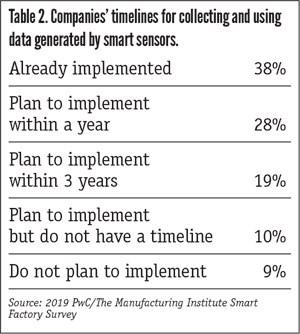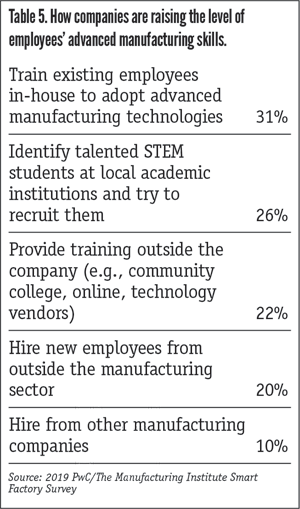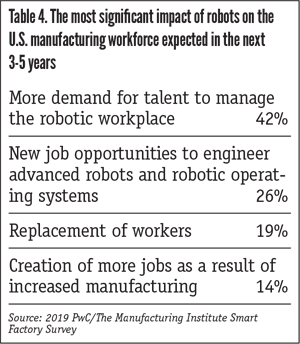Implementing the Fourth Industrial Revolution
Many names have been given to the current state of technology in manufacturing including the Industrial Internet of Things (IIoT), the Fourth Industrial Revolution (4IR) and Industry 4.0.
#iiot #automation
To track where this new industrial revolution stands, PwC (www.pwc.com) joined forces with The Manufacturing Institute (www.themanufacturinginstitute.org), the research arm of the National Association of Manufacturers (www.nam.org) in surveying 100 U.S.-based manufacturers on how they were navigating these new waters. Juliane Stephan, director of PwC Digital Operations, presented the results in a recent Industry Week webinar.2
Most of the manufacturers surveyed regard Industry 4.0 with measured optimism, Stephan said. Many are also already at some stage of making systemic changes using the new technologies.
“Companies are making progress,” she said, “but scaling and linking investment to value remain a work in progress.”
WHERE IS 4.0 NOW?
Around 40% of the businesses surveyed had not started to implement Industry 4.0 initiatives, Stephan said. Almost 20% said they are in the “awareness” stage, where they’ve heard of the technologies, but that’s all. Another 20% are in an “immobile” state—they know of the technologies but haven’t taken action. Stephan pointed out that the huge amount of information out there can result in decision paralysis on the part of some companies, which creates this immobility. Companies in this state want to start but aren’t sure how.
A smaller number of companies (14%) said they’d started experimenting and learning hands-on about Industry 4.0 transformation. The first projects of some of those companies demonstrate proof-of-concept, which can lead to working out how to adapt or change operations and processes to get the most out of the new technology.
Meanwhile, about half of the companies surveyed are in some stage of actively adopting and scaling Industry 4.0 solutions, moving beyond simple proof-of-concept. Stephan said these companies are thinking, “How do we take this beyond one successful line or one successful plant to the whole company?”
TECHNOLOGIES BEING DEPLOYED
IoT appears to be focused on collecting real-time data from the shop floor. That means connecting to machines, labor and materials, then creating the ability to determine the flow of product, bottlenecks and other realities without having to go into a plant.
AA makes use of the data collected from IoT and conventional sensors. Such analysis can be useful in optimizing factory scheduling of machines and parts given current inventory levels and capacity. Analytics also can optimize setup time, minimize waste in the system and offer customers a high service level.
AI is closely related to AA, Stephan explained. The two “go hand in hand. Usually, you can’t do AI until you understand AA.” An AI solution, for example, might have a machine make an adjustment determined by the analytics from sensor data instead of having a human make that adjustment, Stephan said.
3D printing is another important enabler for Industry 4.0. Companies have been using it for rapid prototyping for some time. Now, it can substitute certain parts in the manufacturing process. Still, Stephan warned that companies “need to be deliberate about which parts.” In the supply chain, 3D-printed spare parts made on-demand and onsite can prevent downtime caused by long lead times for certain equipment, she said. The 3D-printed part could either bridge the time until a spare can get there, or, for some parts made of certain materials, do the job itself.
Surprisingly, Stephan said, AR showed up as one of the technologies deployed in the last three years in 28% of the companies surveyed. AR projects images or other visual representations or data upon live images or visual representations. It is being used effectively to guide operators and maintenance staff in conducting best practices for running and repairing or maintaining equipment.
GROWTH AND RESILIENCY
Industry 4.0 transformations from small pilot projects to larger projects bring many opportunities and challenges, including the need to provide a return on investment.
Stephan offered summaries of goals and challenges for these transformations:
Long-term goals for implementing 4IR technologies
- Improved operations across traditional manufacturing dimensions (productivity, quality, reliability, responsiveness)
- Greater and real-time visibility into performance status and operating risks, including the ability to identify risks before they have an impact on safety or production
- Competitive advantages from differentiated and connected products and services, such as enhancing products with IoT capability to allow remote maintenance monitoring
- Faster and more proactive customer service, including better and quicker anticipation of customer needs, the ability to recommend additional products or services, and other features consumers are accustomed to because of their experiences with Amazon
Challenges of complex transformation
- Increased investment/cost, especially in older or outdated plants
- Lack of expertise/knowledge/skillsets within an organization
- Uncertain/ambiguous results: it’s not easy to quantify or calculate return on investment.
DEPLOYMENT OF SMART SENSORS
Industry 4.0 innovations using smart sensors are widely accepted as necessary tools going forward; however, companies are implementing them in different ways in different time frames.
For example, 80% of manufacturers plan to deploy sensors to enhance manufacturing/operations processes within the next three years. The survey revealed the following implementation time frames (Table 2):
As this table shows, 38% of the companies surveyed already have implemented smart sensors in at least some applications. An additional 47% plan to deploy smart sensors in the next three years. About 20% of the companies do not plan to implement smart sensors or do not have a timeline for deployment.
It can be costly to retrofit equipment with sensors, and sometimes the payoff is not clear. A sensor by itself does not provide value, Stephan said. To find cost-effective applications, manufacturers have to ask where it makes sense in the operation to deploy smart sensors and where they will provide the most value. Typically, early deployments target pain points such as process steps that cause bottlenecks.
ROBOTS FINDING THEIR NICHE
Often, robots are seen as symbolic of new manufacturing technology. Companies that have deployed robotics in some way find significant benefits in different aspects of manufacturing (Table 3). Increased productivity is to be expected, but another significant benefit is that automating dangerous tasks can improve worker safety.
WORKFORCE OF THE FUTURE
While robots have been criticized almost from the time they were invented as a potential source of fewer jobs, the surveyed companies revealed that investing in robotics often has the opposite experience. Table 4 shows that 19% of the companies expected robots to replace some workers in the next three to five years, while 82% expected implementation of robot technology to increase their need for workers during that time. In many cases, the new jobs require stronger technical knowledge and skills. Because of this, a challenge going forward will be to have the right workforce talent to use the robotics effectively, Stephan said.
Companies seeking to bolster their workforce with advanced manufacturing skills take a number of different approaches (Table 5). Familiar methods include in-house and external training. In addition, some companies (26%) identify engineering and other STEM [science, technology, engineering, mathematics] students early in those students’ academic careers then bring them into the plant. In such a case, a company benefits from the students’ newly acquired expertise and introduces them to the company in hopes they will come to work full time after graduation.
BUILDING OUT AN INDUSTRY 4.0 PLAN
Stephan offered four strategies to help manufacturers scale their Industry 4.0 efforts and tie them to the bottom line:
- Start with the outcomes that matter to the business—in the present and looking toward the future. Which problems need solving? What are the worst pain points in an operation? Then, think about the best technologies and partners to get the right solution.
- Think in the context of both growth and contraction scenarios. Some technology improvements will work for both scenarios: They can increase production within a plant’s existing footprint instead of requiring expansion to grow.
- Look outside the organization to scale beyond the pilot phase. It’s hard to keep up with the technology, so look at ecosystem partners, such as academia, the National Association of Manufacturers and technology partners.
- Prepare the workforce for Industry 4.0. Many workers regard new direction as a threat to their livelihood. However, it can mean less risk and a better work life. Be clear in messaging about what the company is trying to achieve. Include the plant staff in those messages and remember they are the ones who will make it happen.
As Stephan said, “We see companies being most effective with their transformation projects when they think first of the outcomes they want to create. That means they usually have a much more focused and successful initiative, not only to succeed in the market today but also 5, 10, 15 years from now.”
BARBARA DONOHUE is web editor of VALVE Magazine (www.valvemagazine.com). Reach her at bdonohue@vma.org.
Resources:
- www.cnbc.com/2019/01/16/fourth-industrial-revolution-explained-davos-2019.html
- https://www.industryweek.com/webinars/webinar-4ir-buzzword-reality-smart- factory-adoption-rates-best-practices- and-leading
RELATED CONTENT
-
Piping Codes and Valve Standards
As with every intended use for valves, piping carries its own set of standards that valve companies and users need to understand.
-
DBB and DIB: Which is which?
The term “double block-and-bleed (DBB)” carries a lot of misconception when it’s used to describe valve functionality.
-
An Overview of ASME B16.34-2017
The content of American Society of Mechanical Engineers (ASME) Standard B16.34 is essential to those who deal with flanged, threaded and welded-end valves.















 Unloading large gate valve.jpg;maxWidth=214)